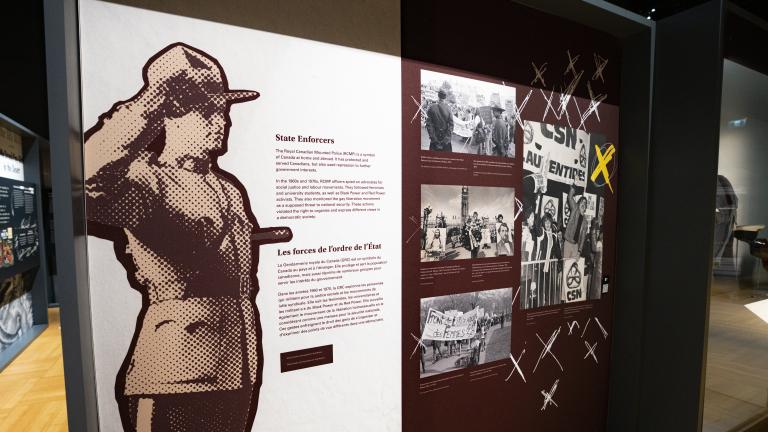News release details
From the 1950s to the 1990s, the Government of Canada systematically investigated, harassed and fired 2SLGBTQI+ members of the Canadian Armed Forces, the RCMP and the federal public service – over 9,000 of them. Now called “the LGBT Purge,” this official policy destroyed thousands of careers, did untold psychological damage and ruined lives.
This Friday, a new exhibition called Love in a Dangerous Time: Canada’s LGBT Purge will bring this largely unknown chapter in Canadian history to visitors at the Canadian Museum for Human Rights (CMHR). It shares stories of the Purge, including its origins in the mentality and attitudes of the Cold War, through first‐hand testimony from survivors, official government documents and inspiring works of art.
“No one should live in fear that their employer is monitoring their social activities, relationships, or sexual activity, or that the truth of your identity could be used to ruin your life and career,” said Matthew Cutler, Vice‐President of Exhibitions. “This exhibition honours the pain, courage and resistance of those who were purged – survivors who transformed their experiences into action for a better future. It is a reminder that the fight for our communities to thrive, to express queer joy without fear and to belong everywhere in our society continues today.”
Among the survivors featured in the exhibition is Michelle Douglas, Executive Director of the LGBT Purge Fund, who was expelled from the military due to her sexual orientation.
“One of the more devastating, shattering parts of being purged is the feeling that you are completely alone,” said Douglas. “The fight that has been carried for decades by survivors of the Purge is a testament to the fact that we were not alone. By sharing our stories, by naming what happened to us, we make sure that we are never alone, and that generations of Canadians will hopefully never again have to endure persecution for being part of the 2SLGBTQI+ community.”
Douglas launched a landmark legal challenge against the military’s discriminatory policies against LGBT service members which finally put an end to Canada’s discriminatory policies in 1992.
Others stepped forward and in 2016, launched a class action lawsuit that led to a $145 million settlement in 2018 and an official apology from the Government of Canada. The settlement included funds for legacy projects, including this exhibition, to honour those who did not live long enough to receive compensation.
The LGBT Purge Fund manages the settlement funds and has been a partner in the creation of this exhibition.
Love in a Dangerous Time: Canada’s LGBT Purge opens to the public on Friday, January 31, and will run until early 2026 before touring to other destinations across Canada. The LGBT Purge is also the focus of a travelling pop‐up exhibit created by the CMHR currently on display on Vancouver Island, and a permanent niche in the CMHR’s Canadian Journeys gallery.
———————————————
Exhibition Highlights from Love in a Dangerous Time: Canada’s LGBT Purge
The Regulation of Desire:
At the heart of the exhibition is The Regulation of Desire, a captivating and immersive film installation by Noam Gonick, made in collaboration with the Royal Winnipeg Ballet. This evocative piece portrays fractured bodies in motion, crafting a moving narrative of the Purge experience.
The Fruit Machine: A Space Opera:
In the 1960s, the Government of Canada funded a research project known as the Fruit Machine. Tests were developed to attempt to reveal a person’s sexual orientation, including showing erotic images and attempting to measure pupil dilation and asking questions to try and determine how masculine or feminine a person was. It was based on false ideas of gender and sexuality. The Fruit Machine: A Space Opera is a short film by Shawna Dempsey and Lorri Millan that situates the Fruit Machine’s assumptions, tests and failure within post‐Second World War Canada’s notions of “normality.”
The Bar:
Step into an immersive re‐creation of a vibrant 1960s bar, like the one located within the Lord Elgin Hotel in Ottawa, known as a sanctuary for the queer community. This engaging space invites visitors to explore the camaraderie and challenges of the era.
The Dark Room:
Venture into the Dark Room, an intensive immersive experience resembling an interrogation room. A striking one‐way mirror presents moving images on a monitor, coated with a reflective film, designed to evoke a chilling sense of being watched. Accompanying audio clips of survivor oral histories bring haunting realities to life, offering insights into the harrowing experiences of those who were interrogated during the Purge.
Ask a Question and Meet LGBT Purge Survivors and Activists:
Visitors have the unique opportunity to engage directly with survivors of the LGBT Purge and some of the upstanders who supported them. This interactive feature invites visitors to speak their questions out loud and receive insightful responses from over a dozen survivors and activists who lived through and helped dismantle the Purge.
Contemporary Issues Wall:
The Contemporary Issues Wall features a large, interactive display that invites visitors to use their hands to uncover hidden words showcasing the achievements of the 2SLGBTQI+ community. As visitors interact, larger “constellations” of accomplishments emerge, but if they pause too soon, challenges identified by the community will obscure those victories, highlighting the need for continued action towards a world where everyone is protected by human rights.
